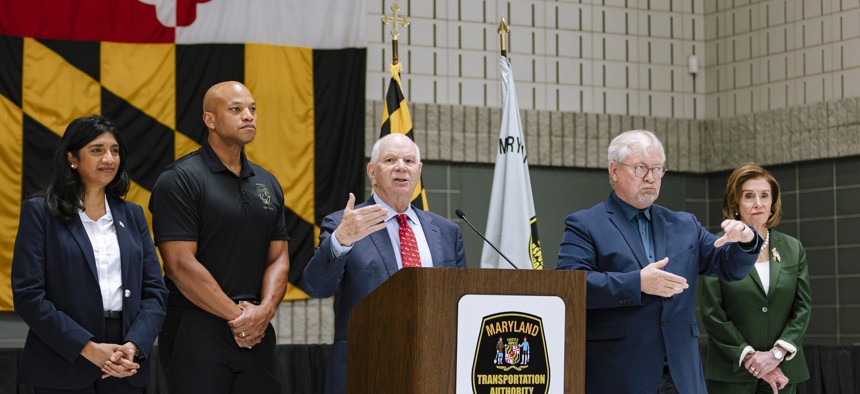How Maryland’s social media team responded to Baltimore bridge collapse

Then-Sen. Ben Cardin (center) and Maryland Gov. Wes Moore (second from left) among those at a press conference after the Key Bridge collapse in Baltimore last year. The Washington Post via Getty Images
The Key Bridge collapsed a little over a year ago after a container ship collided with a supporting pier. Communications staff had the mammoth task of keeping the public informed and dispelling misinformation.
Just over a year ago, the world’s attention shifted to Baltimore as the 47-year-old Key Bridge collapsed early one morning after a container ship collided with a pier that supported it.
The collapse led to the death of six road construction workers, disrupted operations at the Port of Baltimore and set off a scramble as agencies from the federal, state and local governments moved quickly to respond then set in motion the bridge’s rebuilding.
For the state’s social media team in its Office of Communications, the bridge collapse and its immediate aftermath presented numerous challenges, not just the logistics of getting into Baltimore to provide on-site communications support. They needed to combat misinformation and conspiracy theories that quickly spread, as well as provide the public with details rapidly across numerous social media platforms.
Working out who would be the best messenger to give out various pieces of information was also a challenge, as the task could either be left to local agencies or state officials. Sometimes, Gov. Wes Moore might be the best public spokesperson, while others would be best for other more technical topics.
“There were so many questions that we had to figure out as soon as possible,” Shane Wade, a senior digital strategist in the Maryland Office of Communications, said during a recent Route Fifty webcast. “That first 12 hours was just a scramble of reassuring the public that this wasn't an attack of any sort. This wasn't any sort of terrorism. There were also conspiracy theories obviously going out there that this is intentional, that they did this on purpose.”
Perhaps the most challenging aspect of the communications strategy after the bridge collapse was avoiding any legal difficulties. Wade noted that the state uses social media as a “public facing documentation tool,” and in doing so they had to be responsible about what they said or else they risked jeopardizing future litigation. One misstep, incorrect information or a post that misspoke could have had negative consequences, he said.
“I think we did a really great job of being transparent with the public, being honest with the public and managing the crisis as responsibly as we could, while also letting our teams internally know that we know as much as [they] do,” Wade said.
The social media strategy after the bridge collapse required a lot of partnership-building between communications staffers and the myriad state, federal and local agencies that responded to the scene. Wade said he would “basically live in their offices” in the immediate aftermath of the incident to see what they were seeing and make sure the lines of communication were as clear as possible.
Getting communications approved by lawyers for public release was also difficult, especially as each agency has different procedures, while military branches like the U.S. Coast Guard have an approvals process of their own. Being agile was key, in that instance.
“If something wasn't able to get turned out in time, oftentimes, we would not just cut it, but delay it for later on, or we would just have one of our partners use it,” Wade said. “If we're taking footage from the Navy salvage team and we're running out of time to use it in a slide deck for one of our presentations that the governor is giving in about an hour … instead of having the governor speak on this, let's have the actual Navy team who's right next to the governor put it on their part of the presentation.”
Otherwise, it’s important for governments’ communications staffers to work closely with their legal teams during incidents like the bridge collapse. Often, satisfying lawyers before posting on social media means trimming down language where “there's times where we want to be a little bit more loquacious with our language,” Wade said.
“They're pretty amicable; we've built good relationships with them,” he said. “As long as we're providing context for them, like we're sending this copy with this video, and doing that to communicate this message, as long as we're packaging things in a way that's understandable, the process is a lot smoother than even I expected. They're humans too. Once they understand what we're trying to do, it gives them better context.”
Also important from a communications standpoint was being sensitive in handling the deaths of the six construction workers, as well as the uncertainty that surrounded two others on the same crew who were missing.
“This was an emotional and critical time for the state, but for them, it still is. It's painful,” Wade said. “Those first few hours, no one knew if they were alive, if they had been washed down the river, if they had somehow gotten out and just were lost. We had to be responsible in making sure that we were telling people we were putting our best foot forward and trying to save them, if it was even a possibility, and then, most importantly, recovering the bodies.”






